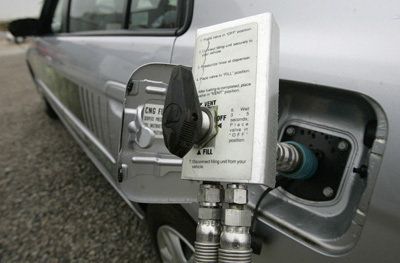
Surprise: the most eco-friendly car sold in America isn't the Toyota Prius. It's the Honda Civic GX, which runs on compressed natural gas, according to the American Council for an Energy Efficient Economy. It might come as a shock to hear that Honda only sells about 1,000 of them each year, mostly to government or corporate fleets because there are few places to fuel up. So exactly what is compressed natural gas (CNG)? The short answer is it's a fossil fuel alternative. The long answer?
Although its combustion does produce some greenhouse gases, compressed natural gas is a cleaner-burning alternative to gasoline, diesel, or propane fuel. Plus, it's abundant in America, and cheap. It is also safer than those conventional fuels in the event of a spill, as it is lighter than air and disperses quickly when released. According to the New York Times' Chris Dixon, "About 95 percent of natural gas is methane, a simple molecule consisting of one carbon atom and four hydrogen atoms. When burned, natural gas produces little more than carbon dioxide and water vapor." Dixon points out the economic benefits of compressed natural gas cars as well:
Honda estimates that fuel for a gasoline Civic costs 8.8 cents a mile. I figured the GX's expense at 5.8 cents a mile when fueling at a Clean Energy station, but only about 3 cents a mile if I were filling up at home, not including the lease or installation costs. With those numbers, anyone would breathe easier.
And, as Arv Voss over at the San Fransisco Gate points out:
Consumers who purchase a new Honda Civic GX may be eligible for a $4,000 federal tax credit when they file their tax return for the year in which the vehicle was purchased. In addition, buyers of the natural gas vehicle home refueling appliance "Phill," by Fuelmaker are also eligible for up to a $1,000 tax credit. Tax credits are calculated, based on the Energy Policy Act of 2005. Phill allows consumers to conveniently and safely refuel a natural gas-powered Civic GX from their home at a much lower fuel cost than gasoline. The home refueling unit sells for approximately $4,000 with installation running roughly $1,300.
Compressed natural gas is made by - you guessed it - compressing natural gas to less than 1% of its volume at standard atmospheric pressure. CNG is used in traditional gasoline internal combustion engines that have been converted to bi-fuel usage (gasoline and CNG). Indeed, almost any existing gasoline car can be turned into a bi-fuel car.
According to Bernard Simon of the Financial Times, a new Toyota CNG hybrid will soon be introduced as part of the company's energy diversity strategy. The new Camry hybrid concept will run on both compressed natural gas and electrons stored in a battery as power sources, and will be the only the second compressed natural gas car on the American market.
Wired's Chuck Squatriglia recently suggested that one reason compressed natural gas vehicles aren't as big in America as they are in Europe is because "we get mundane sedans like the Honda GX while they get sexy roadsters like the Cevennes Turbo CNG." He recently featured the Cevennes, which "updates the classic lines of the Porsche 356 and gives it a modern 1.6-liter turbocharged four-cylinder engine that cranks out 150 horsepower" as well as CNG Ford Mustang that German Green Autogas and haus Rollin on Chrome recently converted to run on compressed natural gas.